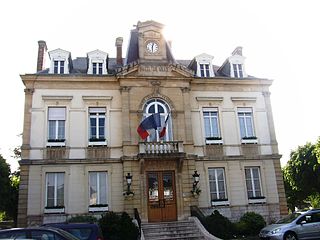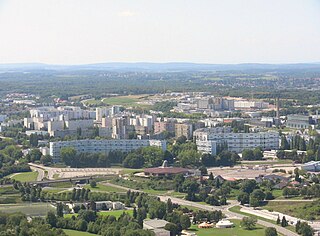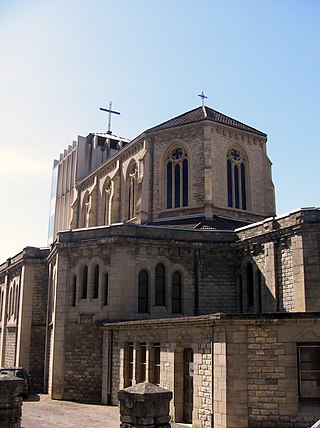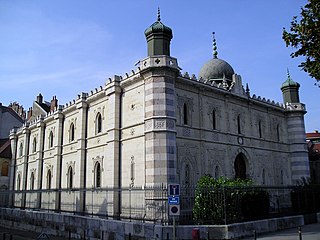
Besançon is the prefecture of the department of Doubs in the region of Bourgogne-Franche-Comté. The city is located in Eastern France, close to the Jura Mountains and the border with Switzerland.

Arpajon ( ) is a commune in the Essonne department in the Île-de-France region of northern France.

Chessy is a commune in the eastern suburbs of Paris, in the Seine-et-Marne department in the Île-de-France region in north-central France. It is located 30.6 km (19.0 mi) from the center of Paris.

Bussy-Saint-Georges is a commune in the eastern suburbs of Paris, France. It is located 25.5 km from the center of Paris, in the Seine-et-Marne department in the Île-de-France region in north-central France.

Dammarie-lès-Lys is a commune in the south-eastern suburbs of Paris, France. It is located in the Seine-et-Marne department in the Île-de-France region 43.3 km (26.9 mi) from the center of Paris.

Avanne-Aveney is a commune in the Doubs department in the Bourgogne-Franche-Comté region of eastern France.

Planoise is an urban area in the western part of Besançon, France, built in the 1960s between the hill of Planoise and the district of Hauts-de-Chazal. It is the most populous district of Besançon, with 15,378 inhabitants. Its inhabitants are called Planoisiens and Planoisiennes.

The Chaprais or Chaprais is a district of Besançon, which was developed from the second half of the 19th century. Located in north-east of the historic center, it has 15,500 inhabitants which makes the second bigger area of the city
The Grette is a little area of Besançon, located near the center of the city.

The Canton of Besançon-Planoise is a former administrative division in the departement of Doubs and in Franche-Comté region. It had 20,407 inhabitants (2012). It was disbanded following the French canton reorganisation which came into effect in March 2015. It consisted of three areas of Besançon: Planoise, Tilleroyes and Châteaufarine.

La Passerelle (French) or the Gateway (English) is a local newspaper distributed in the area of Planoise, in the city of Besançon.

Micropolis is a sector of the area of Planoise, in the city of Besançon, Doubs, Franche-Comté, France.

Hauts-de-Chazal is a new sector of the area of Planoise, located in the west of Besançon.

Francis of Assisi Church is a Roman Catholic church located in the Planoise area in Besançon, Doubs, France. It was built during the 20th century.

The 2005 conflagration of the Forum is a fire which took place in the neighborhood of Planoise, in Besançon. The fire killed the building's concierge and seriously wounded two Chinese student residents.

Sainte-Jeanne-d'Arc is a Catholic church located in the French city of Besançon, in the department of Doubs.

The beginnings of the history of the Jews in Besançon go back to the Middle Ages, a period during which the Jews settled in the city attracted by its activity as a commercial place. The community was founded at the end of the 14th century and, due to its status as a free imperial city, Besançon remained one of the only territories in present-day France to tolerate Jews after their expulsion from the kingdom of France in 1394. The community was nevertheless expelled in turn from Besançon in the middle of the 15th century. The Jews made a tentative return to the city in the 18th century, but it was only after the French Revolution, which emancipated them, that their situation in the Franche-Comté capital stabilized. Although the Jewish community never exceeded 2,000 people except on the eve of the Second World War, it experienced great economic success during the industrial revolution at the end of the 19th century, when the Lipmann family founded LIP, a brand of watchmaking which then became one of the economic engines of the region and remained associated with the name of the city.
Colonial military units composed of African Muslims were stationed in Besançon and the Franche-Comté from the 1870s to World War I to augment the French army and protect its frontiers during its conflicts with Germany. Large-scale immigration of Muslims to France began in the 1960s and 1970s. In 1981, the Center of Islam of the Franche-Comté was created, as the sunna association was formed in 1987. In 2010, Islam was the second largest religion in Besançon after Catholicism. According to a report by France Bleu Besançon in 2010, 15,000 Muslims live in Besançon and comprise about 13% of the city's population.

Centre-Chapelle des Buis, also known as La Boucle, is the district corresponding to the historic center of the city of Besançon. The name La Boucle comes from the meander of the Doubs in which the city originally developed, and whose very shape is that of a loop (Bucle). Until the second half of the 19th century, this district, along with Battant, was the only part of the city of Besançon, before urban expansion into the surrounding areas. The district had a population of 10,659 habitants in 2018, making it the city's sixth most populous district.
The Siege of Besançon was an event during the War of the Sixth Coalition, which occurred in 1814 in Besançon (Franche-Comté), France. The First French Empire, commanded by Napoleon I, engaged in battles with a number of European powers in the early 1800s.


























